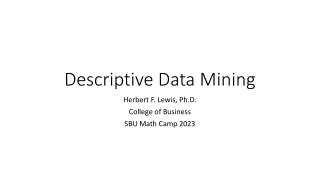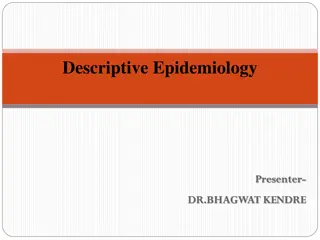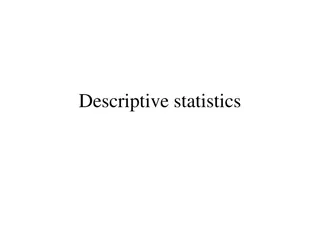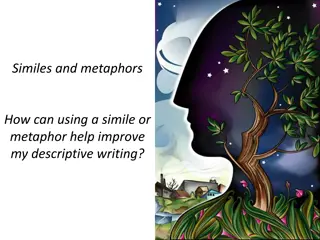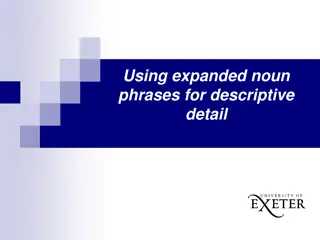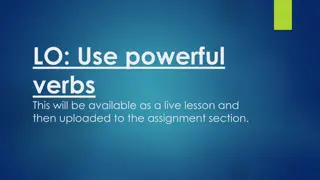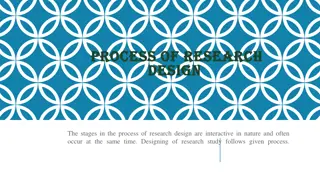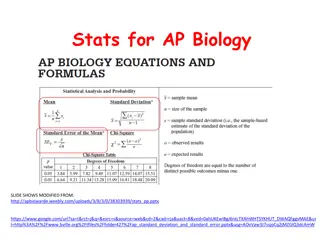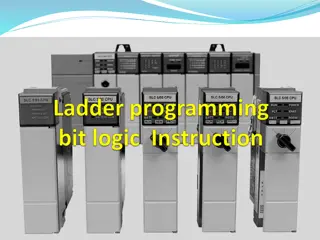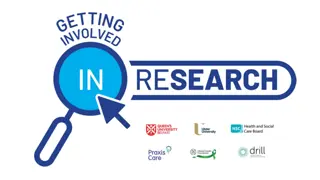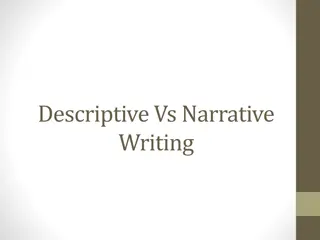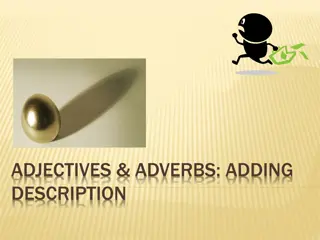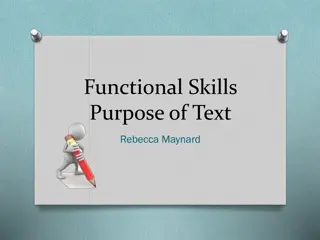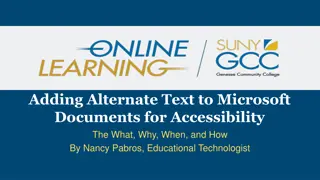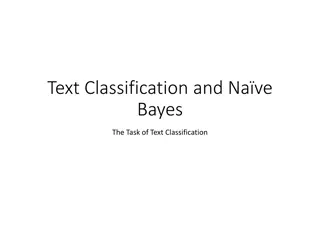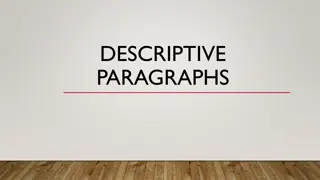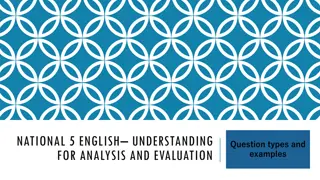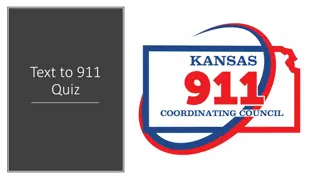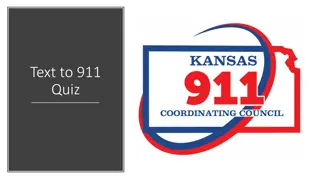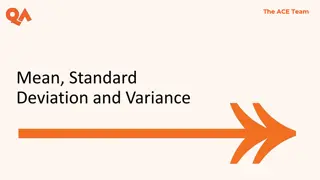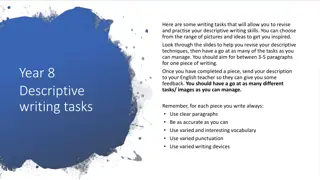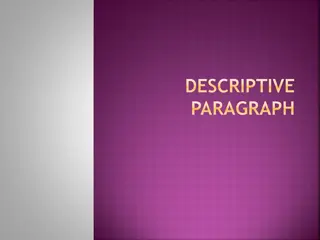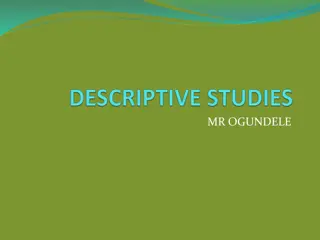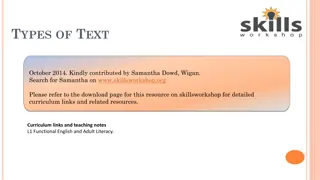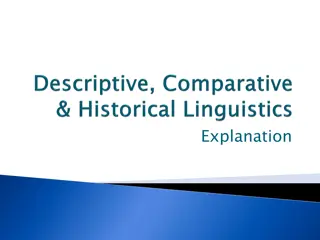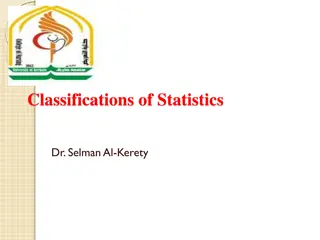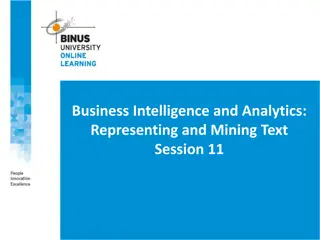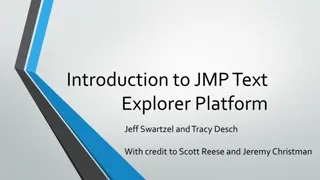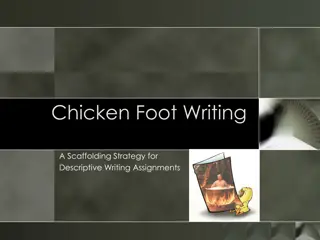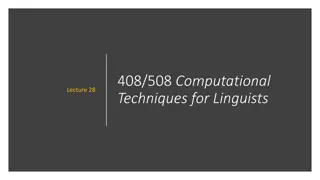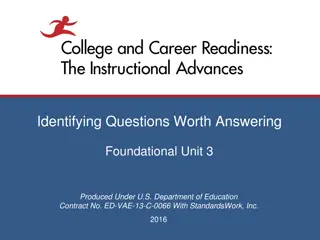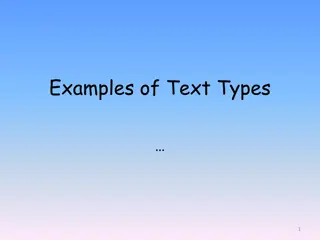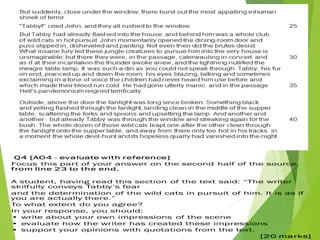Chapter 01 Descriptive Statistics
This chapter provides an introduction to descriptive statistics, covering basic concepts, sampling schemes, graphical representation of data, and numerical description of data. It also explores the role of computers in statistics. The chapter includes computer examples and projects for further pract
5 views • 58 slides
Descriptive Data Mining
Descriptive data mining analyzes historical data to find patterns, relationships, and anomalies, aiding in decision-making. Unsupervised learning and examples of techniques like clustering are explored, showcasing the power of data analysis in business.
1 views • 49 slides
Understanding Descriptive Epidemiology for Health Analysis
Descriptive Epidemiology, presented by Dr. Bhagwat Kendre, explores the distribution of diseases and related characteristics within populations. The study delves into factors like time, place, and person to identify patterns and formulate hypotheses about disease occurrence. Utilizing data from desc
3 views • 36 slides
Understanding Descriptive Statistics in Research
Descriptive statistics are essential in summarizing and analyzing large datasets to uncover trends and tendencies within the data. They include measures of central tendency, dispersion, and skewness, aiding in better understanding and communicating research results. Frequency distributions provide i
0 views • 32 slides
Contrasting Concepts in Political Science: Normative vs Descriptive Approaches
Normative and descriptive concepts in Political Science explore contrasting viewpoints on how things should be versus how they actually are. While normative claims focus on value judgments, descriptive claims deal with facts. These concepts complement each other by providing both theoretical and pra
0 views • 10 slides
Understanding Different Types of Specifications in Estimation and Costing
In the field of estimation and costing, four main methods of specifying are used: Descriptive, Performance, Reference Standard, and Proprietary. Descriptive specifications provide detailed descriptions without using proprietary names, allowing for tight control over specified work. Performance speci
1 views • 9 slides
Enhancing Descriptive Writing with Similes and Metaphors
Using similes and metaphors can greatly enhance descriptive writing by creating vivid imagery and engaging comparisons. This interactive content explores the definition of similes and metaphors, provides examples, and encourages practice through exercises related to the sun, rain, wind, and more. It
0 views • 6 slides
Exploring Descriptive Detail Through Expanded Noun Phrases
Delve into the art of using expanded noun phrases for descriptive richness in writing, as showcased through authentic texts and engaging discussions. Uncover how these linguistic choices bring life to descriptions, enhance imagery, and spark creativity in readers' minds.
0 views • 6 slides
Immersive Rainforest Adventure for Year 3 Students
Embark on a virtual journey to explore the Amazon Rainforest through descriptive writing, observation tasks, and punctuation exercises. Dive into the lush setting as if you were a resident animal, enhancing your language skills with vivid imagery and engaging activities. Experience the beauty and my
0 views • 13 slides
Mastering Powerful Verbs for Descriptive Writing
Learn how to enhance your writing by incorporating powerful verbs. Practice identifying verbs, adverbs, and nouns, and unleash your creativity by crafting sentences using dynamic action words. Explore the vivid descriptions of natural disasters like volcanic eruptions through engaging activities and
0 views • 7 slides
Understanding the Process and Types of Research Design
The process of research design involves interactive stages occurring simultaneously, leading to the creation of a structured study. There are three main types of research design: exploratory, descriptive, and experimental (or causal). Each type has its own objectives and methods. Exploratory researc
0 views • 7 slides
Understanding Descriptive Statistics in AP Biology
Descriptive statistics play a crucial role in analyzing and interpreting data in AP Biology. They include mean, sample size, standard deviation, and standard error, helping researchers arrive at conclusions, support arguments, and communicate findings effectively. Knowing how to calculate and interp
0 views • 30 slides
Introduction to Structured Text in PLC Programming
Structured text is a high-level text language used in PLC programming to implement complex procedures not easily expressed with graphical languages. It involves logical operations, ladder diagrams, and efficient control logic for industrial automation. Concepts such as sensor input, logic operation
5 views • 23 slides
Understanding Research Methods: Quantitative, Qualitative, and Mixed Approaches
This introduction provides an overview of qualitative, quantitative, and mixed methods research, highlighting key differences and various types of research approaches. It delves into exploratory, descriptive, and causal research methodologies, offering insights into problem discovery, data collectio
0 views • 50 slides
Understanding Descriptive vs. Narrative Writing Styles
Delve into the nuances of descriptive and narrative writing, exploring the differences between these two styles. Learn how each style conveys information, from sensory details in descriptive writing to storytelling in narratives. Discover similarities between the two styles and how to structure essa
2 views • 9 slides
Understanding Adjectives and Adverbs for Descriptive Writing
Learn how adjectives and adverbs enhance writing by adding specific details about people, objects, and actions. Adjectives modify nouns to make sentences more descriptive, while adverbs provide additional information about verbs or adjectives. Discover the importance of using these descriptive words
0 views • 26 slides
Understanding Functional Skills: Text Analysis and Application
This instructional text guides learners through the purpose of functional skills in analyzing different types of text, such as skimming and scanning, and understanding the features of various text genres. It includes activities to practice skimming, scanning, and detailed reading, with a focus on de
0 views • 13 slides
Enhancing Accessibility Through Alternate Text in Microsoft Documents
Explore the importance of alternate text in Microsoft documents for accessibility. Learn what alternate text is, why and when you should use it, and how to add it effectively. Discover the benefits of incorporating alternate text and the legal aspects related to accessibility under Section 508. Enha
0 views • 23 slides
Text Classification and Nave Bayes: The Power of Categorizing Documents
Text classification, also known as text categorization, involves assigning predefined categories to free-text documents. It plays a crucial role in organizing and extracting insights from vast amounts of unstructured data present in enterprise environments. With the exponential growth of unstructure
0 views • 28 slides
Mastering Descriptive Writing: Creating Vivid Images with Words
Utilizing descriptive paragraphs helps writers paint a vivid picture for readers by engaging all senses through specific language and adjectives. This guide explores the components of a descriptive paragraph, from the topic sentence to supporting details and a concluding statement. Learn how to use
0 views • 17 slides
Understanding Audience and Purpose in Text Analysis
When analyzing written texts, identifying the purpose and audience is crucial. The purpose reflects the reason behind the text, while the audience indicates who the text is intended for. By recognizing these aspects, one can better understand the content, language, and overall impact of the text. Va
1 views • 50 slides
Exploration of Various Poetry Forms: Descriptive, Narrative, Dramatic, and Metaphysical
Poetry is a diverse art form encompassing descriptive portrayal, storytelling narratives, engaging dialogues, and profound metaphysical insights. Descriptive poetry vividly captures objects and scenes like paintings, narrative poetry weaves interconnected stories, dramatic poetry involves dialogues,
0 views • 11 slides
Essential Information on Text-to-911 System
Explore key details about the text-to-911 system, including capturing text conversations, handling abandoned calls, transferring text calls to queues, and managing text conversations effectively. Learn about system configurations, call release timings, and dispatcher capabilities in handling text me
0 views • 12 slides
Text-to-911 System Operations Quiz
Test your knowledge on Text-to-911 system operations with this quiz. Learn about capturing text conversations, handling abandoned calls, transferring calls to queues, text conversation timelines, and more. Enhance your understanding of the protocols and procedures involved in managing text-based eme
1 views • 12 slides
Understanding Descriptive Statistics: Mean, Standard Deviation, and Variance
Explore the fundamentals of descriptive statistics focusing on mean, standard deviation, and variance. Dive into the importance of these measures in interpreting data patterns effectively, with practical examples like analyzing the average height of individuals and understanding central tendency met
1 views • 23 slides
Enhancing Descriptive Writing Skills Through Engaging Tasks
Explore a variety of writing tasks designed to enhance descriptive writing skills, including using nouns, adjectives, verbs, and adverbs creatively. Learn about descriptive techniques such as metaphors, similes, and imagery to enrich your writing. Practice choosing precise vocabulary to create diffe
0 views • 8 slides
Exploring the Art of Descriptive Writing
Descriptive writing aims to immerse readers in a sensory experience by vividly portraying people, places, or things through carefully chosen details. Description paragraphs should focus on action over sensations, providing essential information in a clear, detailed, and chronological manner. The ele
0 views • 5 slides
Understanding Descriptive Epidemiology in Public Health
Descriptive epidemiology involves the study of disease occurrence and distribution in populations. It focuses on describing patterns of disease occurrence based on who gets sick, where rates are highest and lowest, and temporal patterns of disease. Descriptive studies are essential for public health
0 views • 18 slides
Understanding the Four Types of Text in English
Explore the four types of text - instructive, informative, persuasive, and descriptive - with examples and features. Enhance your ability to identify and analyze different text types effectively.
0 views • 14 slides
Statistical Analysis: Descriptive and Inferential Techniques Overview
Understanding statistical analysis involves both descriptive and inferential techniques. Descriptive statistics focus on summarizing data, including measures of central tendency and dispersion. In contrast, inferential statistics use sample data to make inferences about populations and test hypothes
0 views • 19 slides
Evolution of Linguistics: From Philosophy to Descriptive Study
Linguistics has evolved significantly from being a branch of philosophy to a distinct field called Descriptive Linguistics. It now focuses on studying language in itself rather than in relation to other disciplines, aiming to describe and analyze the structure and operation of languages at different
0 views • 20 slides
Different Classifications and Guidelines for Descriptive Statistics
This content discusses the two broad classifications of statistics - descriptive and inferential. It delves into descriptive statistics, which help organize and summarize numerical data, and explores various ways to categorize them. It covers measures to condense data, central tendency, variability,
0 views • 26 slides
Understanding Text Representation and Mining in Business Intelligence and Analytics
Text representation and mining play a crucial role in Business Intelligence and Analytics. Dealing with text data, understanding why text is difficult, and the importance of text preprocessing are key aspects covered in this session. Learn about the goals of text representation, the concept of Bag o
0 views • 27 slides
Introduction to JMP Text Explorer Platform: Unveiling Text Exploration Tools
Discover the power of JMP tools for text exploration with examples of data curation steps, quantifying text comments, and modeling ratings data. Learn about data requirements, overall processing steps, key definitions, and the bag of words approach in text analysis using Amazon gourmet food review d
0 views • 23 slides
Chicken Foot Writing: A Scaffolding Strategy for Descriptive Assignments
Chicken Foot Writing is a helpful tool for organizing and structuring descriptive writing tasks, guiding students through transforming rough notes into well-constructed paragraphs. This strategy, developed by Keith Brown, aids in independent thinking and efficient completion of literary assignments
0 views • 8 slides
My Adorable Cat Miumiu - A Descriptive Text
The text describes a small, playful, and clever cat named Miumiu. It highlights Miumiu's features such as soft brown fur, long tail, round eyes, and playful nature. The text explains the function and features of descriptive texts, emphasizing their use of simple present forms, adjectives, and adverb
0 views • 20 slides
Understanding Bigrams and Generating Random Text with NLTK
Today's lecture in the Computational Techniques for Linguists course covered the concept of bigrams using NLTK. Bigrams are pairs of words found in text, which are essential for tasks like random text generation. The lecture demonstrated how to work with bigrams, including examples from the NLTK boo
0 views • 19 slides
Enhancing Reading Comprehension Through Text-Dependent Questions
This resource delves into the significance of text-dependent questions in improving students' reading comprehension skills by emphasizing the importance of evidence from the text, building knowledge through nonfiction, and developing critical thinking abilities. It highlights key advances in educati
0 views • 16 slides
Examples of Different Text Types Explained
Explore various text types through a collection of slides, each providing insights into different forms of written content. From narrative to descriptive, this visual guide presents a comprehensive overview of text classifications, helping to broaden your understanding of communication styles.
0 views • 11 slides
Analyzing the Writer's Vivid Depiction of Horror in the Second Half of the Text
In the second half of the text, the writer skillfully portrays a sense of horror that immerses the reader in the narrator's surroundings. The descriptive imagery creates a vivid and tangible experience, evoking a feeling of being present in the harrowing situation. This analysis explores the impact
0 views • 6 slides

